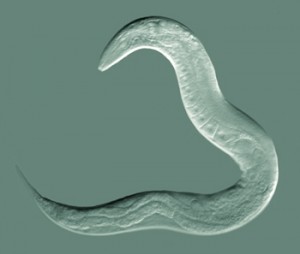A Glowing Blue Death Wave Envelops Roundworms Before They Expire
Studying nematodes as life leaves them may lead to insights into exactly how death travels through the body, and, perhaps, whether we can delay it
/https://tf-cmsv2-smithsonianmag-media.s3.amazonaws.com/filer/Deathwave%20small.jpg.jpeg)
In 1907, The New York Times described an experiment in which physician Duncan MacDougall attempted to quantify the moment of death in six human subjects by weighing the departure of their souls. “Dr. MacDougall’s object was to learn if the departure of the soul from the body was attended by any manifestation that could be recorded by any physical means,” the Times wrote. Though MacDougall’s conclusions–that the soul weighs 21 grams–were later discredited for dubious methodology, quantifying the means of death’s arrival and the way life departs continues to perplex scientists and the public alike.
In the years since MacDougall announced his faulty conclusions, researchers have come to understand the method of individual cell death. Apoptosis, or programmed cell death, tidily claims 50 to 70 billion cells in the adult human body every day, while necrosis, or premature cell death, occurs when cells are fatally injured. How death eventually takes hold of an entire organism remains elusive, however.
Now, an international team of researchers has found evidence of a “cascade” of death that spreads through an animal’s body through a special necrosis pathway, leaving a wake of dead cells in its procession, until the entire system collapses and expires. In the roundworm Caenorhabditis elegans, this wave of bodily destruction originates in the intestine and is accompanied by an intense burst of blue fluorescence when viewed with a camera equipped with a high brightness fluorescence filter cube, which allowed the researchers to visualize the worm’s destruction, the team reports in the journal PLoS Biology.
“We’ve identified the chemical pathways of self-destruction that propagate cell death in worms, which we see as this glowing blue fluorescence traveling through the body,” said senior author David Gems of University College London, in a press release. “It’s like a blue Grim Reaper, tracking death as it spreads throughout the organism until all life is extinguished.”
Actually, scientists have known for years that C. elegans–a type of nematoda, their official taxonomic phylum–glow this eerie blue, but were baffled about its reason. A leading hypothesis was that the blue glow may be due to damaged lipids and proteins (a substance called lipofuscin), which glow under a UV light and are related to aging. In the current study, the research team tested this hypothesis by damaging some of the C. elegans’ cells with heat and increased oxygen levels, which would have produced heightened levels of lipofuscin if that material was indeed responsible for the glow. No new blue fluorescence resulted, however, implying that something else was driving the glow.

A healthy C. elegans. Photo by Bob Goldstein, UNC Chapel Hill
To figure out the glow’s true cause, the team set up time-lapse imaging to record aging C. elegans as they approached death. When the animals stopped wiggling–indicating that they were about two hours away from death–the team noticed a “striking and sudden” 400 percent increase in blue fluorescence. The blue wave originated in the intestine, which runs the length of the worm, then spread its toxic touch into other tissues. The glow faded about 6 hours after death.
The same glow resulted when the worms were intentionally killed by heat, disease or freezing, and appeared in both young and old worms experiencing death throes. The team chemically defined the blue fluorescence as caused by a molecule called anthranilic acid, and they dubbed the phenomenon “death fluorescence.” As the worms begin to die, organelles in the worms’ guts burst and anthranilic acid is released. Though once concentrated in the organelle, the anthranilic acid diffuses through the worm’s body. The less acidic conditions of the molecule’s new environment lends the substance its fluorescent properties–when viewed with the filter cube, the incident light is now able to excite the molecules, triggering the burst of fluorescence, the team determined experimentally.
The researchers hypothesized that the death fluorescence originates from a cascade of necrosis, which is driven predominantly by calcium ions signaling cells to stop functioning. When the researchers turned off that chemical’s transport through the worm’s body by using binding proteins and engineered nematodes with special mutations that blocked signaling molecules, they could reduce death fluorescence and partially delay death due to causes such as infection and freezing. When they attempted to block this same pathway while the worms were in the process of succumbing to death by old age, however, they could not slow the inevitable. “This suggests that aging causes death by a number of processes acting in parallel,” Gems said.
Nonetheless, the research suggests that death, in these worms at least, is closely associated with the gut. But questions still remain: Does freezing and infection target the digestive systems of these worms, and blocking calcium signaling allows the gut to remain intact and the worm to survive? In the case of death by old age, do other systems fail first, leading to an eventual shutdown of the digestive system, triggering death fluorescence? Answering these questions, of course, will take more research.
Furthermore, because mammals and C. elegans share similar necrotic pathways, the study’s authors hypothesize that studying nematodes may lead to insights into how death goes about its business in other animals, and, perhaps, even elucidate ways to delay that process. The authors write:
Here there are potential parallels in human aging: estimations of the likely upper limits of human longevity have calculated that removal of a major age-related disease (e.g., cardiovascular disease, cancer) would cause only small increases in lifespan. This is because multiple pathologies act in parallel to increase age-related mortality.
“Together, the findings cast doubt on the theory that aging is simply a consequence of an accumulation of molecular damage,” Gems concluded. “We need to focus on the biological events that occur during aging and death to properly understand how we might be able to interrupt these processes.”
/https://tf-cmsv2-smithsonianmag-media.s3.amazonaws.com/accounts/headshot/Rachel-Nuwer-240.jpg)
/https://tf-cmsv2-smithsonianmag-media.s3.amazonaws.com/accounts/headshot/Rachel-Nuwer-240.jpg)